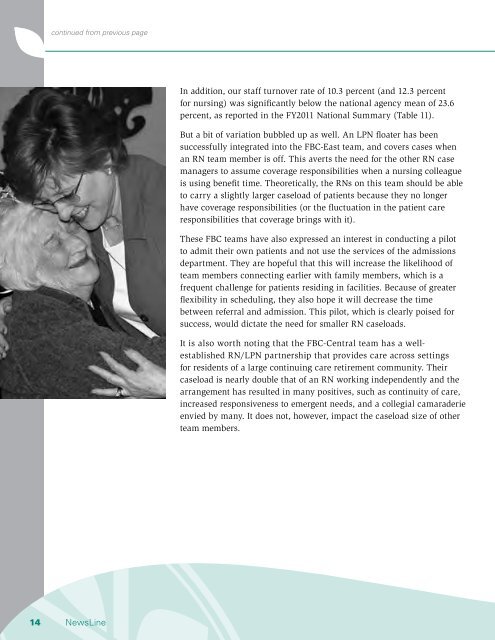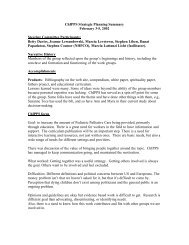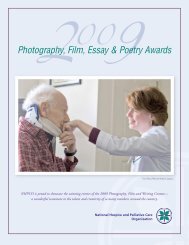PDF version - National Hospice and Palliative Care Organization
PDF version - National Hospice and Palliative Care Organization
PDF version - National Hospice and Palliative Care Organization
Create successful ePaper yourself
Turn your PDF publications into a flip-book with our unique Google optimized e-Paper software.
continued from previous page<br />
In addition, our staff turnover rate of 10.3 percent (<strong>and</strong> 12.3 percent<br />
for nursing) was significantly below the national agency mean of 23.6<br />
percent, as reported in the FY2011 <strong>National</strong> Summary (Table 11).<br />
But a bit of variation bubbled up as well. An LPN floater has been<br />
successfully integrated into the FBC-East team, <strong>and</strong> covers cases when<br />
an RN team member is off. This averts the need for the other RN case<br />
managers to assume coverage responsibilities when a nursing colleague<br />
is using benefit time. Theoretically, the RNs on this team should be able<br />
to carry a slightly larger caseload of patients because they no longer<br />
have coverage responsibilities (or the fluctuation in the patient care<br />
responsibilities that coverage brings with it).<br />
These FBC teams have also expressed an interest in conducting a pilot<br />
to admit their own patients <strong>and</strong> not use the services of the admissions<br />
department. They are hopeful that this will increase the likelihood of<br />
team members connecting earlier with family members, which is a<br />
frequent challenge for patients residing in facilities. Because of greater<br />
flexibility in scheduling, they also hope it will decrease the time<br />
between referral <strong>and</strong> admission. This pilot, which is clearly poised for<br />
success, would dictate the need for smaller RN caseloads.<br />
It is also worth noting that the FBC-Central team has a wellestablished<br />
RN/LPN partnership that provides care across settings<br />
for residents of a large continuing care retirement community. Their<br />
caseload is nearly double that of an RN working independently <strong>and</strong> the<br />
arrangement has resulted in many positives, such as continuity of care,<br />
increased responsiveness to emergent needs, <strong>and</strong> a collegial camaraderie<br />
envied by many. It does not, however, impact the caseload size of other<br />
team members.<br />
14 NewsLine









